

Biogeochemistry of Carbon and Nitrogen in Aquatic Environments
Research Topics Index Project Home
|
Our study site is an unconfined sand and gravel aquifer located on Cape Cod, Mass., that was contaminated by the disposal of dilute, treated sewage for more than 60 years. The sewage was discharged onto surface infiltration sand beds and then percolated downward to the water table. The practice produced a contaminant plume that is >6 km long and consists of an ammonium-containing core, surrounded by an oxic-suboxic, nitrate-containing outer zone. This site has been utilized for a variety of multidisciplinary studies on the fate and transport of contaminants and microorganisms in groundwater by numerous investigators. Carbon and nitrogen are two principle components of the groundwater contaminant plume and are the focus of our research studies at this site. |
|
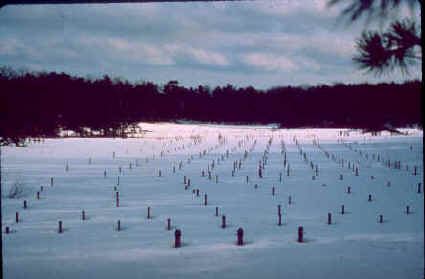
Monitoring wells of the large scale array south of the sewage disposal beds, Massachusetts Military Reservation, Cape Cod. |
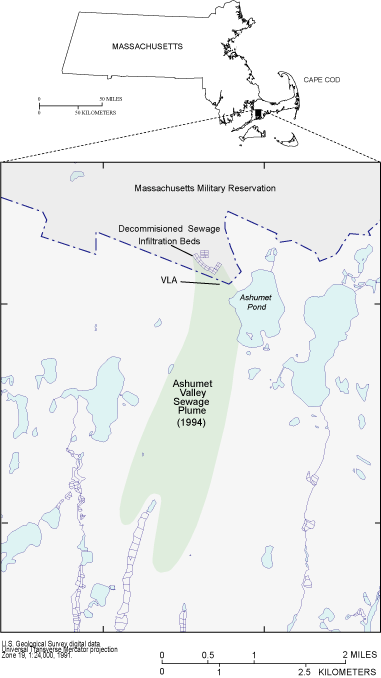 |
Bladder and pump used for injecting chemical tracers into well sites in the large scale array. |
|
| Nitrate contamination of shallow groundwater is an undesired side effect and a key concern for many land-use and water-disposal practices in the U.S. Nitrate is a mobile ion, posing risks to human and animal health in drinking water supplies. It also affects surface water habitats as it is transported and ultimately discharged to the surface by ground-water flow. However, microbial processes in the subsurface can alter nitrogen speciation, affecting the rate of transport and the amount of fixed nitrogen that is present. Nitrification and denitrification are the two processes that have the greatest consequence. This project uses laboratory studies, geochemical signatures of ground-water constituents, and in situ tracer tests to examine how these processes function within a sandy aquifer. Laboratory tests characterize some of the factors that control the processes and include molecular and biochemical characterization of the microorganisms responsible. Detailed determinations of the aquifer geochemistry (e.g., nitrogen speciation, natural abundance of N and O isotopes, and trace constituent characterization) are interpreted within the context of each nitrogen-cycling process. Tracer tests constitute an ecosystem level study, which carefully maintains the in situ nature of an aquifer and its unique physical environment. Tracers are introduced into groundwater and transported through an undisturbed section of the aquifer by natural ground-water flow before being intercepted by multilevel wells. Interpretation of the results is facilitated with computer models that are developed specifically for these tracer tests. The approach enables examination of the individual steps of the denitrification and nitrification pathways in groundwater and the extent to which electron-donor and electron-acceptor supply control these processes. The information obtained from this study regarding nitrification and denitrification and the resulting development of field-tested coupled reaction transport models facilitates evaluation of the role(s) of these processes in other aquifers across the country and the net effect they have upon subsurface nitrogen contamination. | ||
 |
 |
|
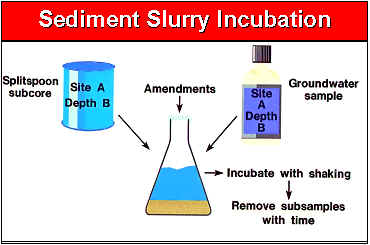
Diagram of sediment slurry incubation technique used in the laboratory to measure nitrogen cycling processes. |
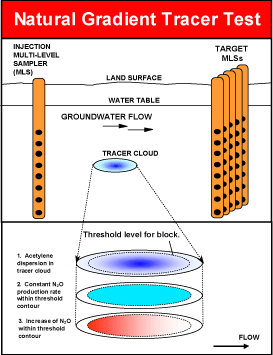
Diagram of a natural gradient tracer test (top) using the acetylene block technique to measure in situ denitrification and the distribution of acetylene in the tracer cloud and its subsequent effect on nitrous oxide accumulation (bottom). |
|
|
Funding: US Dept of Agriculture; USGS Toxic Substances Hydrology Program;USGS National Research Program. |
||
Reports
|
||
| Oxygen is a key ground-water constituent, controlling both the geochemistry and microbiology of an aquifer. Accordingly, aerobic respiration, the microbial process that consumes oxygen, is fundamentally important to the overall functioning of the aquifer. It is controlled by the available electron supply, which usually is represented by the amount of degradable carbon present. This is a project that examines oxygen consumption in the Cape Cod aquifer from several different scales. Groundwater at the site is characterized by both vertical and horizontal gradients of oxygen and organic carbon. The first approach is a km-scale determination of oxygen isotope natural abundance and correlation with total and dissolved organic carbon and reduced nitrogen. At the meter-scale, oxygen consumption is being examined in situ using natural gradient tracer tests with air and 18O. Thirdly, on the cm-scale, oxygen consumption is being assessed in the laboratory using microcosm incubations to quantify biological oxygen demand in aquifer core material. Again, correlations with extractable organic carbon and reduced nitrogen and in conjunction with determination of oxygen consumption kinetics is providing important information regarding aerobic respiration within the subsurface and the overall interaction that the process has with the hydrologic regime and natural attenuation of the Cape Cod contaminant plume. | |
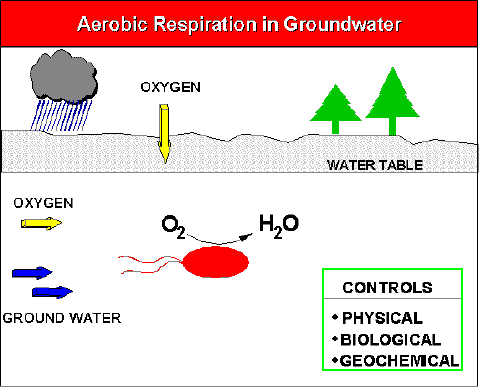 |
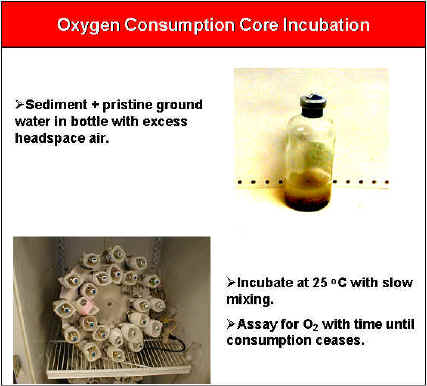 |
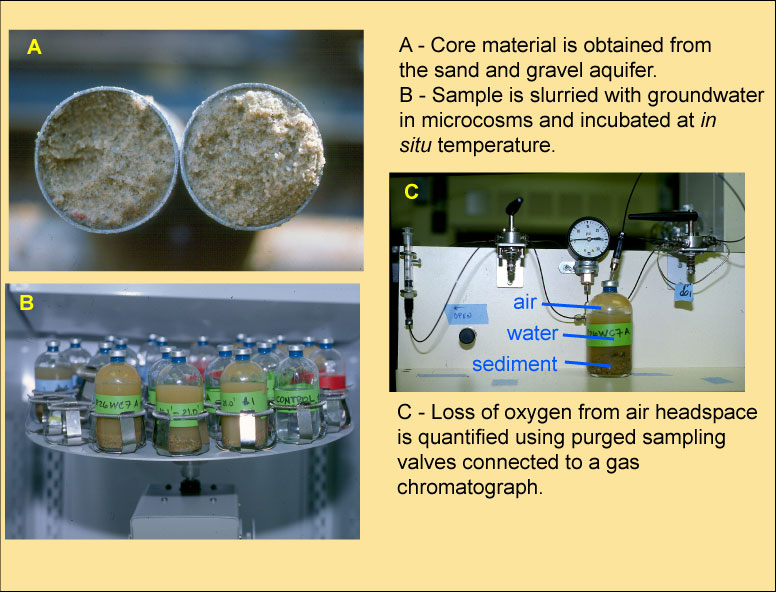 |
Funding:US Environmental Protection Agency USGS Toxic Substances Hydrology Program USGS National Research Program |
ReportsHatzinger, P.B., Palmer, P., Smith, R.L., Penãrrieta, C.T., and Yoshinari, T., 2003, Applicability of tetrazolium salts for the measurement of respiratory activity and viability of groundwater bacteria: Journal of
Microbiological Methods, v.
52, p. 47-58. (on-line
abstract) Smith, R.L., Böhlke, J.K., Revesz, K., Yoshinari, T., Hatzinger, P.B., Penãrrieta, C.T., and Repert, D.A., 1999, In situ assessment of the transport and microbial consumption of oxygen in ground water, Cape Cod, Massachusetts, in Morganwalp, D.W., and Buxton, H.T., eds., U.S. Geological Survey Toxic Substances Hydrology Program--Proceedings of the Technical Meeting, Charleston, S.C., March 8-12, 1999: U.S.
Geological Survey Water-Resources Investigations
Report 99-4018, p. 317-322. (on-line
abstract) Penãrrieta, C., 1998, Assessment of microbial oxygen consumption in Cape Cod aquifer using a natural gradient tracer test and core incubations, M.S. Thesis, Dept. Civil, Environmental and Agricultural Engineering, University of Colorado, 124 p. |
|
In 1995 the source of the Cape Cod sewage plume was shut off when the sewage treatment plant ceased operation. At that time, a long-term study was initiated to document and characterize the evolution and attenuation of the ground-water contaminant plume that had been generated from the disposal practice. This study consists of frequent plume-wide characterization of ground-water constituents along transects oriented longitudinally and transversely with the contaminant plume. Additionally, sediment cores have been periodically taken and characterized for oxygen consumption capacity and sorbed and extractable organic and inorganic materials. In situ oxygen consuming capacity is also being examined using continuous injection tests with oxygenated water. A goal of this study is to delineate the processes that dominate natural ground-water attenuation. |
|
|
A
(A) Map illustrating transect and well localities between sewage disposal beds and Ashumet Pond. Longitudinal cross sections of nitrate (B) and ammonium (C) concentrations in Cape Cod contaminant plume in June 1997. |
B
C
|
Funding:USGS Toxic Substances Hydrology Program; USGS National Research Program. |
|
ReportsLeBlanc, D.R., Hess, K.M., Kent, D.B., Smith, R.L., Barber, L.B., Stollenwerk, K.G., and Campo, K.W., 1999, Natural restoration of a sewage plume in a sand and gravel aquifer, Cape Cod, Massachusetts, in Morganwalp, D.W., and Buxton, H.T., eds., U.S. Geological Survey Toxic Substances Hydrology Progam--Proceedings of the Technical Meeting, Charleston, S.C., March 8-12, 1999: U.S.
Geological
Survey Water-Resources Investigations Report 99-4018,p. 245-260. (on-line
abstract) Smith, R.L., Kumler, B.A., Peacock, T.R., and Miller, D.N., 1999, Evolution of a ground water sewage plume after removal of the 60-year-long source, Cape Cod, Massachusetts: Inorganic nitrogen species, in Morganwalp, D.W., and Buxton, H.T., eds., U.S. Geological Survey Toxics Substances Hydrology Program--Proceedings of the Technical Meeting, Charleston, S.C., March 8-12, 1999:
U.S. Geological Survey Water-Resources Investigations Report 99-4018, p.
285-292. (on-line
abstract) Hess, K.M., LeBlanc, D.R., Kent, D.B., and Smith, R.L., 1996 Natural resoration of a sewage-contaminated aquifer, Cape Cod, Massachusetts: Hydrology and Hydrogeology of Urban and Urbanizing Areas, Proceedings of the Conference, Boston, MA, April 21-24, 1996, American Institute of Hydrology, Minneapolis, MN, p. WQE13-WQE25. |
|
Larry
Barber, USGS, Boulder, Colo.
J.K. Böhlke, USGS, Reston,
Va.
Steven
P. Garabedian, USGS, Northborough, Mass.
Kathy
Hess, USGS, Northborough, Mass.
Doug
Kent, USGS, Menlo Park, Calif,
Denis
LeBlanc, USGS, Northborough, Mass.
Paul
Matheson, Worchester Polytechnic Institute, Worchester, Mass.
Daniel
N. Miller, USDA, Clay Center, Neb.
Ken
Stollenwerk, USGS, Lakewood, Colo.
Kinga
M. Revesz, USGS, Reston, Va.
Tadashi
Yoshinari, NY Dept. Health, Albany, N.Y.
Cape Cod Toxics Field Site Fact Sheet
USGS Toxic Substances Hydrology Program Fact Sheet
| Projects Index Top of Page |
| Return
to Biogeochemistry
of Carbon and Nitrogen in Aquatic Environments Home Page
USGS Home Page | USGS Water Resources | USGS Toxics Hydrology Program | USGS NRP | |